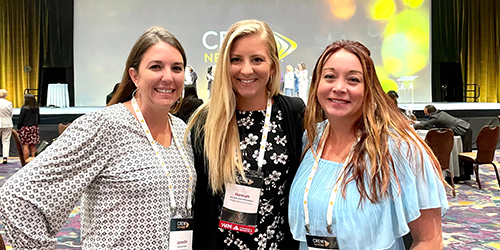Whether it’s about strategic plans, budget numbers, happy hour or free food, every professional in today’s business world is required to share information at some point during the course of their day. And it’s not always easy. How often have you found yourself asking someone, “Didn’t you read the email/memo/flyer, etc.?” How often has the answer been, “I saw it but didn’t read it” or “I read it but forgot what it said”? Effective communication is a challenge we all face.
In the 15+ years I’ve been with Phillips Edison & Company, I’ve held a variety of positions ranging from administrative assistant to analyst to director of learning. In every role I’ve held, I’ve been asked to develop or facilitate communication internally and/or externally in some shape or form. Currently, as Director of Internal Communications, I am tasked with working with the various departments and the management team to plan and develop communications on a variety of topics to our associates. This means making sure that the messages are clear, consistent and delivered in the most effective manner. In short, it means making sure associates pay attention.
People all work differently. They have specific preferences regarding how they want to receive information and varying ways of processing it. And quite frankly, everyone is busy and messages tend to get lost in the shuffle – often leaving them unread. While it’s easy to write an email or memo, it’s not so easy to develop a communication that people will read and that will present the information in an easily digestible format. While technology, content, audience and other factors frequently change how we communicate, there are some basics that remain the same.
Give them a reason to pay attention.
Did the title of this blog get your attention? If so, it was probably either because you wondered what in the world the article could be about or because you truly thought you were getting free donuts. How many times have you seen an email offering free food and half the company showed up within minutes? Now think back to your last memo. How many people responded quickly – if at all? People need to know what’s in it for them. As much as we hate to admit it, people typically focus primarily on themselves and the things that affect them as individuals. They pay more attention if they have a personal, vested interest to do so. Title your communications or start them off with a fact or statement that conveys why the reader should keep reading.
Break it down into bite-size chunks.
Today’s professionals are constantly on the move, bombarded by messages and communications from every direction. It’s easy to fall into the trap of skimming the longer ones quickly or setting them aside for later. Look at the popularity of Twitter or Snapchat which only allow users to send small bits at a time. People are more likely to read a shorter message and remember its contents. If you must write longer communications, use bullet points or numbering to make it more reader-friendly.
Use words that people can easily understand.
Admit it. Books, articles, emails or other communications in which the author uses a lot of big, complicated words are typically at the bottom of your reading pile. Keep your communications simple and cut out the jargon. The more people have to stop and figure out what you are trying to say or go back and re-read, the more likely they’ll give up and stop reading. Write as if your audience reads on the level of an average eighth grader.
Repeat yourself multiple times in multiple ways.
If you have children or deal with them regularly you’ll understand this more than most. You have to say the same thing more than once and in different words to really get your message across. People like to get their information in specific ways and pay more attention to some venues more than others. If your message is important, make sure to give it to them more than once and in different formats.
Make them laugh.
Do you like to laugh? Of course – most people do! Humor catches attention and helps to maintain it. Think about it. Most of us spend 40 or more hours a week reading dry business correspondence. Messages that give us a break from that by incorporating a bit of humor can be both refreshing and more memorable.
Use urgency wisely.
Important. Please Read. I MEAN IT!!! These subject lines might grab your attention the first few times you see them but eventually they lose their meaning. Overusing them guarantees that people will stop reading your communications. Find other ways to get their attention (see: “Give them a reason to pay attention” and “Make them laugh” above). Personally, I like to offer them free food. Works every time.
Published On Oct 02, 2015
in Leadership & Development





